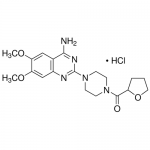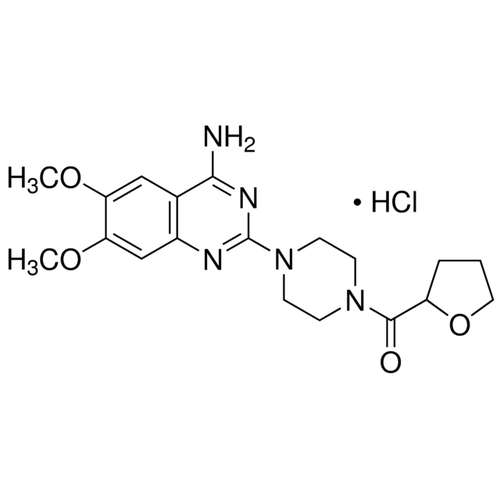| Product Name | Terazosin |
| Description |
Alpha adrenergic antagonist, and Hsp90 Activator |
| Purity | >98% |
| CAS No. | 63074-08-8 |
| Molecular Formula | C19H25N5O4·HCl |
| Molecular Weight | 423.89 |
| Field of Use | Not for use in humans. Not for use in diagnostics or therapeutics. For in vitro research use only. |
Properties
| Storage Temperature | -20ºC |
| Shipping Temperature | Shipped Ambient |
| Product Type | Antagonist |
| Solubility | Soluble to 20mg/ml in warm water |
| Source | Synthetic |
| Appearance | White to off-white solid |
| SMILES | C1=C(OC)C(=CC2=C1C(=NC(=N2)N3CCN(CC3)C(=O)C4CCCO4)N)OC.[Cl-].O |
| InChI | InChI=1S/C19H25N5O4.ClH.H2O/c1-26-15-10-12-13(11-16(15)27-2)21-19(22-17(12)20)24-7-5-23(6-8-24)18(25)14-4-3-9-28-14;;/h10-11,1 |
| InChIKey | MWYNOTLRCUQCKD-UHFFFAOYSA-M |
| Safety Phrases |
Classification: Not a hazardous substance or mixture. Safety Phrases: S22 - Do not breathe dust. S24/25 - Avoid contact with skin and eyes. S36/37/39 - Wear suitable protective clothing, gloves and eye/face protection. Hazard Statements: H302 - Harmful if swallowed. |
| Cite This Product | Terazosin Hydrochloride (StressMarq Biosciences Inc., Victoria BC CANADA, Catalog # SIH-516) |
Biological Description
| Alternative Names | 1-(4-Amino-6,7-dimethoxy-2-quinazolinyl)-4-[(tetrahydro-2-furanyl)carbonyl]piperazine |
| Research Areas | Alpha-2 Adrenergic Receptors, Apoptosis, Cancer, Neuroscience, Neurotransmitter Receptors |
| PubChem ID | 44383 |
| Scientific Background | Terazosin Hydrochloride, traditionally used as an alpha1-adrenergic receptor antagonist, has gained attention in neuroscience for its protective effects in models of stroke and sepsis. It activates phosphoglycerate kinase 1 (Pgk1) and heat shock protein 90 (Hsp90), leading to anti-apoptotic effects in macrophages. These mechanisms suggest potential neuroprotective roles, particularly in conditions involving ischemic injury and neuroinflammation. Its ability to modulate cell survival pathways makes it a candidate for further exploration in neurodegenerative disease models. |
| References |
1. Chen X., et al. (2015) Nature Chem Biol. 11:19-25. 2. Hancock A.A., et al. (1995) J Recept Signal Transduct Res. 15: 863. 3. Kyncl J.J. (1986) Am J Med. 80:12. |



Reviews
There are no reviews yet.